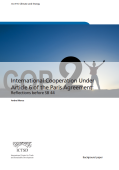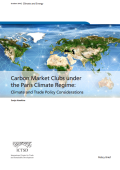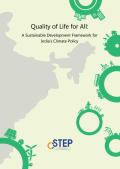

China’s introduction of a national ETS, scheduled for 2017, is an important development in the expanding carbon market landscape. As countries move towards implementation of the recently-adopted Paris Agreement, this sends a powerful signal about China’s mitigation commitment and support for carbon markets. As the largest emitter of greenhouse gases and a key player in world trade, China’s move to a nation-wide ETS can have significant implications for the future of carbon markets around the world.

The United Nations 2030 Agenda for Sustainable Development, adopted in September 2015, includes Sustainable Development Goals with respect to climate change (SDG 13) and to ensuring access to sustainable energy (SDG 7). Questions of mitigation and adaptation to climate change are furthermore integrated throughout the Agenda. This think piece explores how trade rules, in particular, those established at the multilateral level, could support progress towards the 2030 Agenda’s objectives related to climate change and clean energy.
The authors focus on six key policy challenges at the intersection of trade policy and climate change and clean energy. They recommend prioritising policy actions in three areas: fossil fuel subsidies; clean energy subsidies; and access, dissemination, and transfer of climate-friendly technologies. The authors also suggest policy actions to tackle three other important issues: dealing with the political economy of local content requirements; pricing carbon nationally while tackling international competitiveness and carbon leakage concerns, and designing “carrots” and “sticks” for more ambitious action under climate clubs.

Carbon markets are expected to continue to play a key role in the mitigation effort under the Paris Climate Agreement. Cooperation in carbon market clubs can help reduce competitiveness and carbon leakage concerns, which has the potential to incentivise the uptake of more and increasingly ambitious carbon markets. This policy brief assesses the potential for carbon market clubs in light of the Paris Agreement and recently launched carbon market initiatives from a climate and trade policy perspective. It shows that additional efforts will be needed within and outside the UNFCCC for carbon market clubs to emerge and explores the challenges and opportunities the trade system may pose in this regard.

India and other countries are expected to submit their Intended Nationally Determined Contributions (INDCs) for the Conference of Parties (COP-21) in December 2015. Keeping in mind the expectation that India will experience severe impacts from global warming and the fact that a large proportion of people still require basic needs and energy services, CSTEP conducted a study examining two scenarios for India’s development by 2030: policy or Business as Usual (BAU) and Sustainable Development (SD) or quality of life.
The study builds on the India Energy Security Scenarios (IESS) 2047 tool developed by NITI Aayog by adding a ‘quality of life’ dimension to the energy and emissions pathways.
